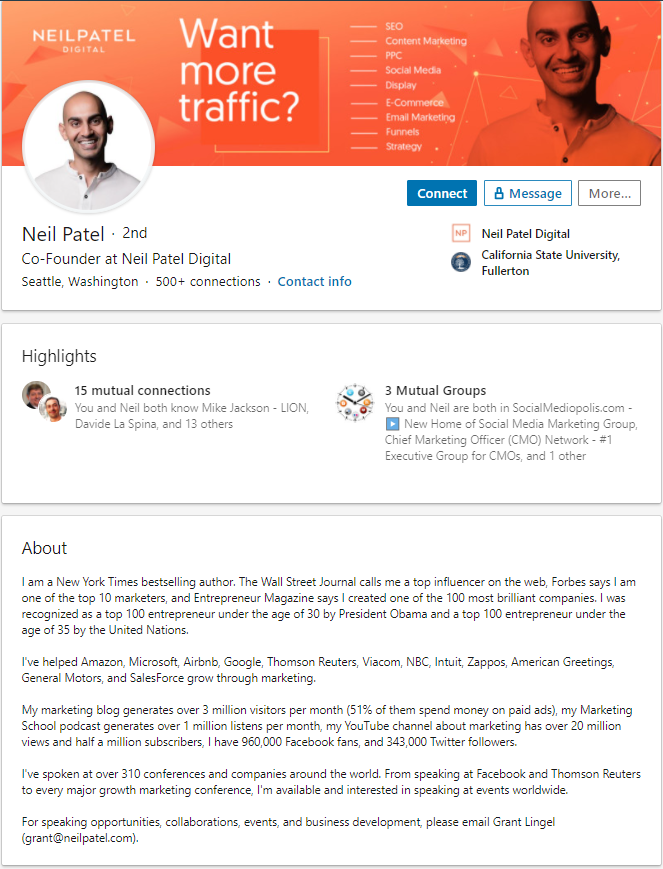Most people find writing a LinkedIn summary difficult. It’s never easy to write succinct and impactful copy, especially when your aim is to drive sales. That’s why you’ll often come across profiles that don’t fully utilize this unique opportunity to convert prospects into leads. It’s easier to focus on your own personal summary, rather than what your business can do for potential clients. Yet by looking at some effective LinkedIn summary examples for sales, you can soon spot some trends that are worth following. We take a closer look at how to write a LinkedIn summary, as well as some general profile tips.

What is a LinkedIn Summary?
A LinkedIn summary is like a highly effective business card. It’s the block of information that sits pretty much at the top of your LinkedIn profile, giving you the chance to really engage with your audience from the off.
From a technical point of view, it’s an open-ended text box that gives you around 2,000 characters to play with. You can write, edit, and rewrite it at any point. Usually, aside from your portrait and personal information, it’s the first thing that people viewing your profile will see.
Below, we’ve outlined an example of a concise and effective LinkedIn summary:
Evidently, it can be an effective tool for driving sales. However, you’ll notice that many people leave it blank. It’s not one of the fields that LinkedIn makes you fill in. Yet it’s essential if you’re trying to attract prospects on LinkedIn and improve your LinkedIn Social Selling (SSI) Index. Your LinkedIn SSI depicts how good you’re at establishing your brand and nurturing relationships.
What are the Benefits of a LinkedIn Summary

When implemented correctly, a strong LinkedIn summary can bring a host of benefits. When you’re using it as part of your lead generation efforts, it can give you an immediate edge. There are several reasons for this:
- You can attract attention. Whether it’s key metrics about your performance or details on what your business or service is, these headline facts and figures can be front and center.
- You can promote your unique selling points. By outlining what differentiates you from other sales teams and professionals, you can stand out from the crowd.
- You can prompt a response. The summary section allows you to include a good CTA that may motivate a potential lead to reach out to you.
- It shows up in search. Your lead generation efforts aside from LinkedIn will often result in a quick search from the potential client. By having a detailed and well-crafted LinkedIn summary, they’ll likely find you and learn more about what you’re offering.
Taking the time to craft a strong LinkedIn summary is evidently worth it. But how should you go about getting started with yours?
Characteristics of a Good LinkedIn Summary for Sales
Several factors may impact how effective your LinkedIn profile summary is. Many of the best LinkedIn profiles stand out because the user has taken the time to consider what it is that people want to see when they’re reading it.
It’s important to bear in mind that, on mobile and most browsers, your profile summary is truncated, with a ‘see more’ option. So, when you’re thinking about how to write a LinkedIn summary, you have to make an impact straight away to encourage users to click to see more. You can do so by making sure you have the following:
A convincing hook
You’ll see that with the best LinkedIn profiles, the goal is to grab the reader’s attention from the off. You need to entice the reader to ‘see more’ of what you have to offer. What is it that your customers will be most interested in knowing about you? This should be your LinkedIn profile headline, and your summary should build on it. You need a clear and concise message outlining how you can help them.
For example: For the past X years, we’ve helped brands in the Y sector accomplish Z results.
A brief outline
You don’t need to cover every single selling point in minute detail. Remember, less is more when it comes to writing a strong copy. Keep to the essentials, and eliminate any fluff and jargon.
For example: Contact me today on [email] or [phone] to learn how your business can achieve X by using [your product/service].
A clear structure
No one is going to read through a huge wall of text. If, when the potential lead clicks on ‘see more,’ they’re greeted with a dense block of writing, they’re not going to sit through it all. Make sure that your summary is formatted so it’s easy to scan, and that all relevant information is easy to pick out.
For example: 1. Explain what you do. 2. Outline who you do it for. 3. Demonstrate why your customers choose you. 4. Give details on how potential leads can contact you.
A personal touch
Whether your profile is your own or representing your brand, it needs to show some personality. Show your passion for the work you do, your opinions on the market, and why clients should choose to do business with you.
For example: Our brand story reaches back n years. In that time, we’ve grown to recognize that achieving X can sometimes be difficult. That’s why we constantly drive to deliver Y, meaning our clients can achieve their goal of Z.
What do you want to achieve with your summary?
When it comes to LinkedIn profile tips, it’s important to bear in mind what you’re hoping to achieve with it. For those in sales roles, it can be hard to know what to put in a LinkedIn summary. However, there are a few clear goals that you should have for your profile:
Drive new leads
As any salesperson knows, there’s never a bad time to try and generate new leads. Your summary should give prospects the chance and inclination to reach out to you. Your compelling copy, persuasive facts, and call to action should all help to encourage a connection.
Increase engagement
By demonstrating your expertise in the summary, you give your voice more authority. When you’re creating content for LinkedIn, a well-written summary can go a long way in proving your credibility. This means that users of all kinds are more likely to respect your insight and engage with your content.
Outline your key selling points
What is it that makes your company stand out from the rest? Your summary should make this point immediately clear, ensuring that you’re at the front of peoples’ minds when they’re thinking of your industry.
Showcase your brand
Your summary is a good chance to show people what the ethos and personality of your company are like. Although LinkedIn is a professional platform, don’t let that discourage you from showing what makes your brand unique. And this also has a positive impact on your LinkedIn SSI.
Appear in searches
LinkedIn pages carry particular weight when it comes to Google’s search algorithm. By having a carefully crafted summary, complete with relevant keywords, it’s more likely that your page will appear in searches. This can be a valuable driver of traffic that converts.
LinkedIn Summary Best Practices for Sales
When it comes to the best LinkedIn summaries, you’ll find that there are a few consistent best practices on display. Some of these are general rules applying to all profiles, while others apply specifically to those of salespeople. We’ve outlined both:
Make it accurate
From the facts and figures about your performance to the spelling and grammar of your summary, everything must be accurate and correct. Check your profile thoroughly, and ask someone else to check for errors. Whether it’s a potential lead or employer, mistakes in your summary are immediately off-putting.
Show your worth
The best LinkedIn summary examples for sales all have one thing in common – they immediately establish how the reader can benefit. For your profile to be a success in generating leads and sales, your audience must know why they should connect with you. This usually depends on the industry you’re in and the people you’re targeting.
Don’t use jargon
Using overly technical or niche terms can also be off-putting for many. Try to keep your language straightforward and to the point. It has more chance of resonating with your target audience.
Use keywords
Make sure your summary is optimized for search engines, including any keywords that your prospects are likely to be searching for. By including these terms, your profile is more likely to show up in searches.
Start Writing Your LinkedIn Summary Today
So far, we’ve covered all of the essential information on what to put in a LinkedIn summary and outlined some LinkedIn summary examples for sales. It’s now time for you to start writing your own. Remember, it’s a process that can take a while, and you may need to make adjustments and refinements over time.
Zopto is a cloud-based social selling and lead generation automation tool, which can help you generate hot leads. Choose from our range of packages and let’s get started. You can also connect with our LinkedIn automation specialist or book a Demo now.
LinkedIn Summary FAQs
Q. How important is a LinkedIn summary?
A. Very. Imagine your summary to be equivalent to your business card. It needs to be succinct, accurate, sell your profile, and result in an action (them contacting you).
Q. Where can I find examples of LinkedIn summaries for sales?
A. The best place is to search your existing connections on LinkedIn. You’re sure to find many connections and related connections who have optimized their summary for sales.
Q. Should I include keywords in my LinkedIn summary?
A. Definitely. Not only does it allow potential leads to see relevant information, but it also means you’ll appear in search engine results related to your industry.
How do I write a good LinkedIn summary?
A good LinkedIn summary should include who you are professionally, your achievements, skills, and what you’re currently working on or interested in.

